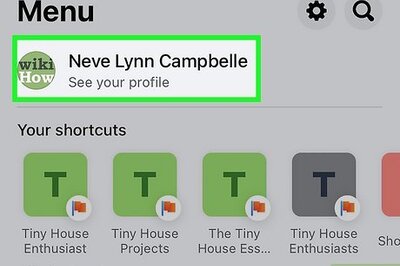
views
X
Research source
Child custody cases arise when parents cannot agree on a plan for raising their children after a separation or divorce.[2]
X
Research source
When the other parent files their lawsuit, they will be required to serve you with a package of information, including the details of their lawsuit and a request for a response. You will have a limited amount of time to formulate a plan, prepare your response, and file your answer. Follow the directions below to successfully file your answer to a child custody lawsuit.
Formulating a Plan

Consider hiring an attorney. If you can afford a family law attorney, you should consider hiring one to help you navigate the child custody process. See this article for directions on how to find a good family law attorney. Even if you cannot afford a full-service attorney, many attorneys provide limited services at a reasonable cost. This means you may be able to hire an attorney to prepare your documents, give you limited legal advice, or potentially even teach you about this area of the law, without having to pay the attorney to take on the entire visitation process.

Read the papers you have been served with carefully. The entire lawsuit will begin when the other parent files a complaint for custody. When the other parent files this lawsuit, they will be required to serve you with all of the documents related to the case. When you get served with these papers, read them right away so you know what your child's other parent is asking the court to do and how you have to respond. The most common documents you will be served with include: The complaint for custody. This document tells the court about you, your child, and your child's other parent. It will also have information about what the other parent is requesting the court to do. In this instance, the complaint will most likely state that the other parent is asking for a certain custody arrangement with the child. The summons. The summons is a document issued by the clerk of courts where the lawsuit was filed and it tells you, the defendant, how long you have to respond to the complaint. The Uniform Child Custody Jurisdiction Enforcement Act affidavit. This standard document will contain information about your child and where they have lived for the past five years. A blank response form. While not required in every jurisdiction, you may receive a blank response form, which is the document you will use to answer the other party's complaint.

Pay attention to deadlines. One of the most important pieces of information you will find in the packet of information you are served with is the strict deadline for responding to the complaint. The deadline will be clearly stated in the summons that you receive. You must respond in some way by the stated deadline or you risk the court entering a default judgment against you. If a default judgment is entered against you, you may not be able to participate in the case and the other party may receive exactly what they asked for in their complaint.
Preparing Your Answer

Determine how you will respond. If your child's other parent has decided to file a lawsuit for custody of the child, you will have an opportunity to respond in a number of different ways. The response you choose will depend on how you want the case to proceed. Consider the following types of responses you could utilize: Do not respond. If you read through the complaint you were served with and decide you do not wish to get involved, you can simply ignore the complaint. If you choose to do nothing, a default judgment will likely be entered on behalf of the other party and they will likely get everything they asked for from the court. This might be a viable option if you agree with all of the other party's proposed actions. However, even if you agree with the other party's proposals, you should consider filing an answer so you have the opportunity to participate in the case. File a motion to dismiss. If you do not think the other party's complaint states any legitimate claim for relief, you can file a motion to dismiss. A motion to dismiss is a document asking the court to throw out the lawsuit. There are a number of reasons a lawsuit could be thrown out including a lack of jurisdiction or a failure to state a claim. For more information about writing and filing a motion to dismiss, look here. Also, look here for a sample motion to dismiss. Submit a counterclaim. A counterclaim is a document that lets the court know what you would like to happen in your custody case. It is a document that looks a lot like the original complaint you were served with, and will lay out the reasons you deserve custody and why the other party does not. A counterclaim is different from an answer. An answer is a direct response to the other party's complaint while a counterclaim includes new facts and new legal claims. For more information about counterclaims, look here. File an answer. An answer is a direct response to the other party's original complaint. An answer will respond to each paragraph of the other party's complaint by allowing you the opportunity to admit, deny, or state that you do not have enough information to respond to each paragraph at issue.

Formulate your answer. When you start to write your answer, look through the documents you received when you were served with the lawsuit as there may be an answer form provided for you. If there is no answer form provided to you, contact the court that the lawsuit was filed in and ask if they have an answer form you can utilize. If no form is available you can create your own answer from scratch. Whether you have a form or are creating your own answer, follow the directions below to write an effective answer. First, create a header that includes your name and contact information, the other party's name and contact information, the title of the court hearing the case, and the case number. Second, go through the complaint paragraph by paragraph and respond to each allegation within. Generally, for each paragraph, you will: (1) admit all of the statements in the paragraph; (2) deny all of the statements in the paragraph; (3) admit some of the statements in the paragraph and deny others; or (4) state that you do not have enough information to know whether the statements in the paragraph are true or not. This is the main body of your answer but that does not mean it needs to be overly complicated. Make the answer simple and straightforward and only include the information necessary to respond to each paragraph's allegations. Third, include a section with other defenses you want to raise. This section will include any other relevant facts you want the court to know about. You might include facts about your relationship with the child and your ability to care for the child that the other party left out of their complaint. Fourth, include a specific request to the court. This will be at the end of your answer and will provide the court with an idea of what you would consider an acceptable outcome. Oftentimes the request will be for a dismissal of the complaint; a granting of whatever relief was sought in the complaint; or a partial grant of relief. The request you make will depend on how you respond to the claims in the complaint. If you agree with the allegations in the complaint, you might ask the court to accept it. However, if you would like to contest the complaint, you might ask the court to deny relief or dismiss the case.

Prepare your answer for filing. Once you have created your answer, you will need to sign the document, make copies, and include a service form. When you sign the document, you may have to do it in front of a notary or in person at the courthouse, so be sure you follow the rules in your jurisdiction. Also, most courts will require that you file an original answer and potentially even a certain number of copies, so be sure you know what to bring to the courthouse when you file your response. Finally, an answer will have to be served on the other party so make sure you provide a service form with your answer. A service form is a certification that will be used when the other party is served and will provide the court with a guarantee that service was conducted.
Filing Your Answer

Go to the appropriate courthouse. Once you have prepared your answer, you will need to file it with the same court the other party filed their complaint with. Make sure you look at the documents you received when you were served to determine the correct courthouse to go to. This information can usually be found on the summons. If for some reason you think the other party filed their case in the wrong county, you can ask the court to move the case to a different county.

File your answer with the clerk of courts. Take your answer and any accompanying documents to the courthouse and file them with the clerk of courts. Ask the clerk of courts to look the documents over to ensure they have been completed correctly. Some courts may want multiple copies of your documents, so be sure you know what your specific courthouse wants. There is usually no filing fee for an answer.

Serve the other party. When you serve the other party, you will hire someone (the sheriff or another competent adult) to give a copy of your filed documents to the other party to look over and respond to. To serve the other party, the person you hire must provide the required documents to them, either in person or through the mail. If you are serving someone through the mail, it must be sent by certified mail. In Pennsylvania, this process must be completed within 30 days of filing your documents with the court. In some states (e.g., Michigan), your answer must also be served on the other party at least five days before the hearing if you provided service through the mail, and at least three days before the hearing if you have the other party served personally. For more information about serving another party, look here. Once you serve the other party with your answer, you will have successfully filed your answer and notified the other party of your filing. From here, the court process will include a number of hearings, conferences, and meetings meant to resolve the child custody lawsuit.


















Comments
0 comment